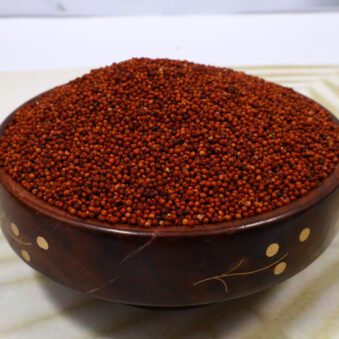- Your cart is empty
- Continue Shopping
Finger Millets (Ragi or Nachni): The Power of Nutrition

Discover the Nutritional Power of Finger Millets (Ragi or Nachni)
Introduction
Are you looking for a nutritious and versatile grain to add to your diet? Look no further than Finger Millets, also known as Ragi or Nachni. This ancient grain has been a staple in various cultures for centuries and is celebrated for its impressive nutritional profile and health benefits. In this blog, we’ll explore Finger Millets through a series of questions and answers, providing you with all the information you need to understand and incorporate this superfood into your life. Whether you are a health-conscious consumer or an importer looking for premium quality grains, Finger Millets are the perfect choice.
What is the difference between a millet and a finger millet?
Millets are a group of small-seeded grains that belong to the Poaceae family. They are highly nutritious and have been cultivated for thousands of years. Finger Millet, specifically, is one of the most popular types of millets. It is known for its high calcium content, making it unique among other millets. While all millets are nutritious, Finger Millet stands out due to its nutrient density and health benefits.
What are millets?
Millets are a group of cereal grains that are widely grown in Africa and Asia. They are highly resilient crops, able to grow in arid and semi-arid regions. Millets are gluten-free and packed with vitamins, minerals, and antioxidants. They are an excellent source of dietary fiber, protein, and essential nutrients like iron, magnesium, and phosphorus.

How do I plant a finger millet, and what care do I need to take for it?
Planting Finger Millet requires a warm climate and well-drained soil. Here are some steps to follow:
- Prepare the soil: Ensure the soil is fertile and well-drained. Finger Millet thrives in loamy or sandy soil.
- Sow the seeds: Plant the seeds during the warm season, ensuring they are spaced appropriately.
- Watering: Water the plants regularly, but do not overwater. Finger Millets are drought-tolerant but still need moisture to grow.
- Weeding: Keep the area free of weeds to ensure the millets get the necessary nutrients.
- Harvesting: Finger Millet is usually ready for harvest in about 3-4 months. Harvest when the grains are hard and dry.
How many calories does cooked Ragi (Finger millet) have?
Cooked Ragi (Finger Millet) contains approximately 350 calories per 100 grams. It is a rich source of complex carbohydrates and dietary fiber, making it an excellent choice for sustained energy release and digestive health.
What type of plant is finger millet?
Finger Millet (Eleusine coracana) is an annual grass that belongs to the Poaceae family. It is known for its hardy nature and ability to grow in poor soil conditions. The plant has a distinctive appearance with finger-like projections on the seed head, hence the name Finger Millet.

How can you give finger millet a taste?
Finger Millet can be used in various delicious recipes. Here are some ways to enjoy its unique taste:
- Ragi Porridge: Cook Finger Millet flour with milk or water to make a nutritious porridge. Add nuts, fruits, or sweeteners for added flavor.
- Ragi Roti: Mix Ragi flour with water and knead it into a dough. Roll out and cook on a griddle to make healthy flatbreads.
- Ragi Dosa: Ferment Ragi batter and make crispy dosas, a popular South Indian dish.
- Ragi Malt: Prepare a refreshing drink by mixing Ragi flour with water, boiling it, and adding jaggery or honey.
Additional Questions
What are the health benefits of Finger Millets?
Finger Millets are packed with health benefits:
- High Calcium Content: Essential for bone health and preventing osteoporosis.
- Rich in Antioxidants: Helps combat oxidative stress and reduce the risk of chronic diseases.
- Supports Weight Loss: High fiber content keeps you feeling full longer, aiding in weight management.
- Controls Blood Sugar: Low glycemic index helps regulate blood sugar levels.
Why should importers choose Finger Millets from India?
 India is one of the largest producers of Finger Millets, known for their exceptional quality and nutritional value. Importing Finger Millets from India ensures you get premium grains cultivated with traditional methods and modern agricultural practices. At Ayaan Naturals, we are both a manufacturer and trader, offering Finger Millets perfect for import markets, bulk suppliers, and white-label brands. Our commitment to quality and sustainability, combined with our extensive experience in manufacturing and trading, makes us a trusted partner for importers worldwide.
India is one of the largest producers of Finger Millets, known for their exceptional quality and nutritional value. Importing Finger Millets from India ensures you get premium grains cultivated with traditional methods and modern agricultural practices. At Ayaan Naturals, we are both a manufacturer and trader, offering Finger Millets perfect for import markets, bulk suppliers, and white-label brands. Our commitment to quality and sustainability, combined with our extensive experience in manufacturing and trading, makes us a trusted partner for importers worldwide.
Conclusion
Finger Millets (Ragi or Nachni) are more than just a nutritious grain; they are a versatile and essential part of a healthy diet. Whether you are looking to improve your health or seeking high-quality grains for import, Finger Millets from India are the perfect choice. At Ayaan Naturals, we ensure that our Finger Millets meet the highest standards of quality and nutrition. Start incorporating this superfood into your diet today and experience its numerous benefits.
Don’t wait—explore the power of Finger Millets now!
